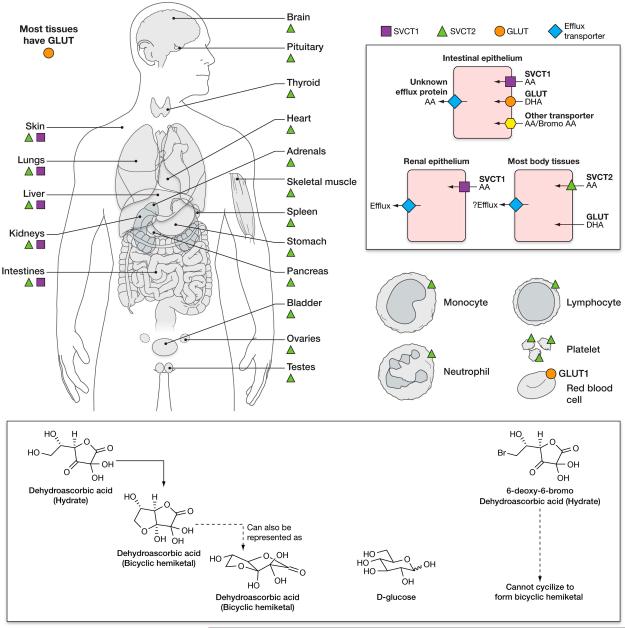Figure 2. Vitamin C transporters.
Distribution of vitamin C transporters in human tissues. Sodium Vitamin C Transporters (SVCTs) are mainly responsible for vitamin C transport into cells in humans and other mammals. SVCT1 is primarily expressed in absorptive tissues, including the intestinal epithelium and the proximal convoluted tubules and the descending part of the loop of Henle in the kidney. SVCT 1 is also expressed in liver. SVCT2 is expressed in most body tissues, as are Glucose Transporters (GLUTs). SVCT 1 and 2 transport ascorbic acid but not dehydroascorbic acid into cells. GLUTs 1, 2, 3, 4 and 8 (but not other GLUTS) (Corpe et al., 2013, Rumsey et al., 2000a, Rumsey et al., 1998, Burzle & Hediger, 2012), transport dehydroascorbic acid but not ascorbic acid into cells. Some GLUTs have a higher affinity for DHA than for glucose. The transporter responsible for exporting ascorbic acid from cells into the extracellular fluid or plasma has not been identified. The only ascorbate containing cell known to lack an SVCT is the mature red blood cell. The red blood cell obtains its ascorbate by transporting dehydroascorbic acid and immediately reducing it internally. Dehydroascorbic acid is transported into human red blood cells by GLUT1, and into mouse red blood cells by GLUT 3 and/or 4 (Tu et al., 2015). D-Glucose closely resembles the ring form (hydrated hemiketal form) of dehydroascorbic acid, which is likely to account for its transport by some GLUTs. When bromo ascorbic acid is oxidized to form bromo dehydroascorbic acid, this compound is not transported by GLUTs. SVCT distribution was inferred by the presence of specific mRNA for SVCT1 and 2, and in some cases by antibodies. Figure based on data from: (Tsukaguchi et al., 1999, Savini et al., 2008) (Daruwala et al., 1999, Wang et al., 1999, Wang et al., 2000).

